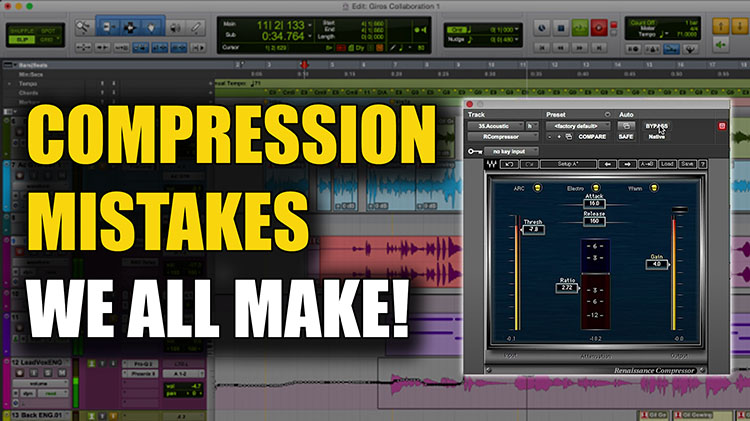Today, I am sharing 5 Compression Mistakes We All Make! From using the wrong attack or release time, to not truly knowing why we are compressing something, these are things we are all guilty of!
All of these tips are also available for you to download as a cheat sheet! Click here to download the cheat sheet!
5. Using Too Fast an Attack Time
This is probably one you have heard before, and I think that is quite valid, because if you use an extremely fast attack time, you are going to mess with your transient, especially with a plugin compressor, which has faster attack times than any piece of hardware could ever do. With plugins, you have look-ahead compressors, which basically annihilate that transient immediately. In most cases, you don’t actually want to do that.
Personally, I like a little bit of transient coming through, and if I want to control that transient I will put a limiter on it. Using fast attack is great if you are trying to encompass the whole signal and make it feel compressed from the get-go, but I try to avoid that unless it is on parallel sources, like parallel drums. If I really want to control those transients, that is where I reach for a limiter to just shave off the top of that transient.
4. Too Slow of a Release Time
You want your release time to be fast enough that it gets out of the way of the next transient, but you don’t want it to be so fast that it’s not really working. On the acoustic guitar I have been working on, when I slowed down the release time too much, it wasn’t getting out of the way of the next big transient, and ended up totally annihilating it, which is not something we want to happen!
3. Compressing For The Sake Of It
Are you just opening up your compressor and putting on the track because you feel like you should, or because you actually need to? It is so important to listen to your sources and make sure you understand exactly where you actually need a compressor, and where you do not.
As we’re talking about attack and release times, if you let that transient just sneak through, you’ve got a slow enough attack time, you can make things more percussive. If you do the opposite, and make the attack time fast, you can grab it early and it is really great for parallel compression underneath a whole drum mix to just add energy to all of the drums.
Compressors are not just about controlling volume and dynamics, they are also providing you with different sounds. So before you reach for your compressor ask yourself why you are using it and make sure you have a reason.
2. Using Presets
I have experimented with presets and I like them when I am starting to get to know a piece of equipment. However, using a preset does not guarantee you the perfect sound. The person who created that preset, no matter how great they are, has not heard your source, they do not know what you are going to be running through that compressor, or how it was recorded.
Presets can be great tools to use as a starting place, or to get ideas of things you could do, but ultimately, learning you compressor, understanding how attack and release work, how the threshold works, and how to apply them is going to be a thousand times better than any preset.
1. Using Compression
The compressor is a tool that we often reach for in this digital world. However, the compressor is not the be all end all, and there may actually be other tools that will get you even better results. for example, saturation can be a way to round off transients in your snare, and may actually give you a louder, fuller sound than you would have gotten if you had used a compressor to round off the transients instead.
Compressors, as amazing as they are, shouldn’t always be your first thought. Think about what sound you are trying to emulate, and then decide if you really need to use compression, or if there is a better tool for you to use in order to achieve that sound.
Watch the video below to learn more about these common compression mistakes!
